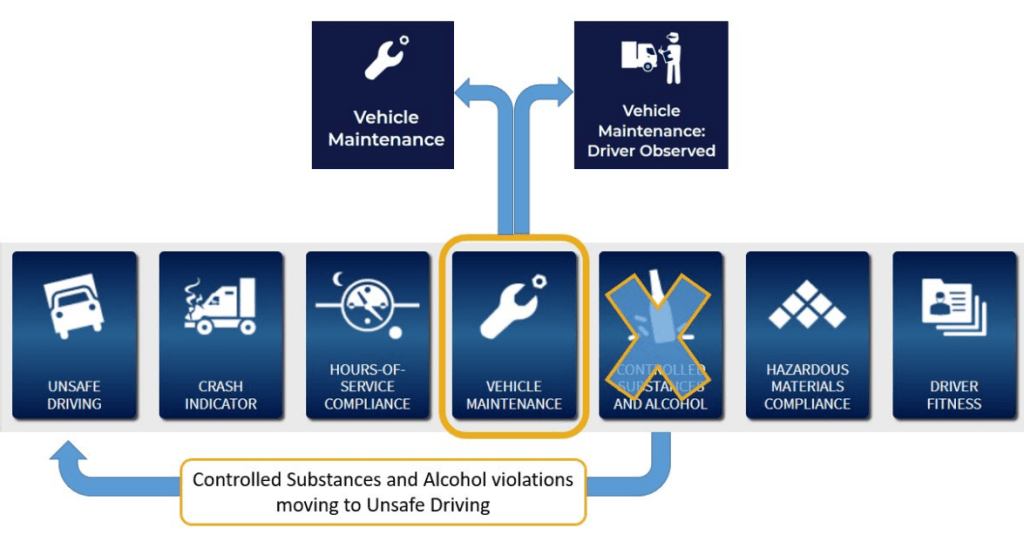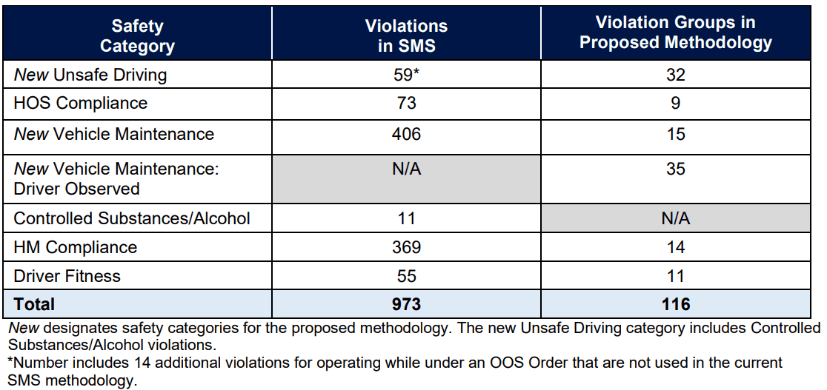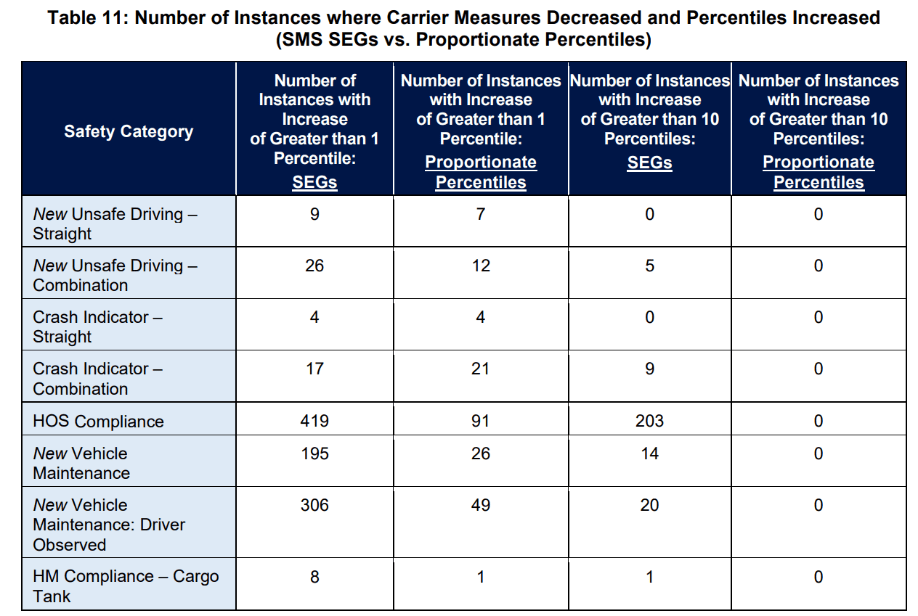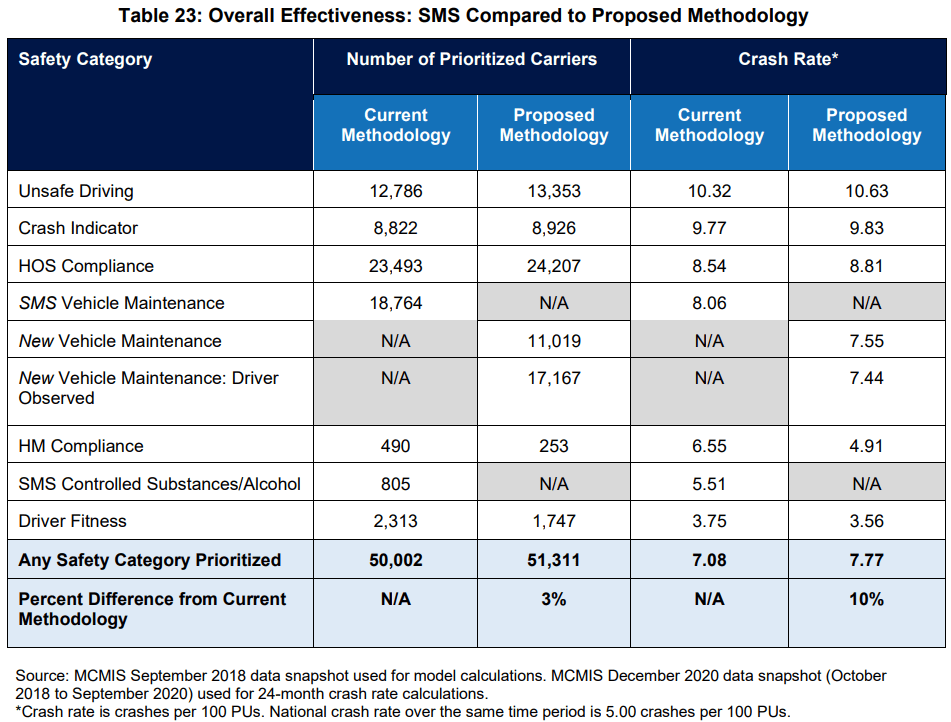On Tuesday, February 14, 2023, the Federal Motor Carrier Safety Administration published a notice requesting comments on proposed changes to the Compliance, Safety, Accountability (CSA) system. The notice comes in response to recommendations from the National Academy of Sciences’ that FMCSA adopt the Item Response Theory (IRT) model to prioritize carriers for safety intervention. Ultimately, FMCSA has concluded that it will not adopt IRT. Instead it is proposing modifying CSA’s Safety Measurement System (SMS) to better calibrate motor carrier scores to more accurately assess carrier’s compliance posture and crash risk.
Details of the proposal are outlined below. Comments are due May 16, 2023. To inform their comments, carriers can log into their CSA portal account to preview how their scores would change under the proposal.
Reorganized BASICs
Perhaps the most significant proposed change is the realignment of the BASICs, which they now refer to as “safety categories.” While the overall number of safety categories would not change, their composition would. Specifically, FMCSA is proposing eliminating the Controlled Substance and Alcohol BASIC and folding it into the Unsafe Driving safety category. Also included in this category would be all violations for jumping an out-of-service order, regardless of the category in which the out-of-service violation occurred.
FMCSA is also proposing to bifurcate the Vehicle Maintenance BASIC into two distinct safety categories: Vehicle Maintenance and Vehicle Maintenance: Driver Observed. The distinction is that violations that could be observed during a pre-trip or a Level II (walk-around) roadside inspection will be added to the driver-observed category, while those more commonly found during a Level I (full) roadside inspection will be applied to the vehicle maintenance category.

Consolidating Violations
Since the inception of CSA in 2010, the number of violations included in the SMS has grown from about 650 to 959. While FMCSA is not proposing eliminating any violations, they are suggesting that distilling these violations into 116 violation groups will simplify the system and improve its accuracy in identifying high-risk carriers. Under the proposal, nothing will change for drivers and carriers on Roadside. Inspection reports will still list all violations discovered using the same violation codes used today. How these violations are used to calculate carriers’ CSA scores, however, will change dramatically. If multiple violations from the same violation group are cited during a roadside inspection, they will be counted as one violation. For example, if a driver is stopped on the roadside and cited for an 11-hour violation and a 14-hour violation to the Hours-of-Service rules, it will only be counted as a single violation. This could be a significant improvement for carriers whose scores are suddenly elevated because of one bad inspection listing several related violations.

Updated Severity Weights
In addition to consolidating violations into groups, FMCSA is also proposing a simplified severity weighting regime. Currently, each violation is assigned a severity weight between one and ten. Under the proposed system violations will be assigned a severity weight of either one or two. Any violation that results in an out-of-service order or is considered disqualifying under 49 CFR §383.51 will be given a weight of two. All others will be weighted one.
Proportionate Percentiles
One of the biggest frustrations of motor carriers related to CSA has been the impact of moving from between safety event (peer) groups. Carriers often experience big jumps, sometimes of more than 20 percentile points, simply by adding or dropping an inspection and being moved to another peer group.

The predominant criticism of this approach is that a change to a carrier’s underlying score should have the greatest influence on its percentile rankings, not its peer grouping. It’s the “measure to percentile” relationship FMCSA is seeking to preserve in the proposal. To accomplish this, FMCSA is proposing a schema that generates a weighted average of a carrier’s percentile scores in each of the two closest safety event groups. This is the carrier’s new percentile score. This is by far the most complex portion of the proposal. Additional information can be found on page 12 of FMCSA’s Foundational Document. FMCSA’s assessment of this provision indicates that while there may still be some variation in carrier percentiles based on the performance of other carriers, its impact is muted. In its analysis, they found that while some carriers did experience an unexpected percentile increase of greater than one, none saw a swing of more than 10 percentiles in any category.
| Carrier Type | Current Threshold | Proposed Threshold |
| General | 80% | 90% |
| Passenger | 65% | 75% |
| HazMat | 75% | 85% |
Safety Category Segmentation
In its proposal, FMCSA acknowledges inequities in the current system. Specifically, that the compliance burden in some safety categories can vary by operational and vehicle type. To address this disparity, FMCSA is proposing segmenting two of the safety categories based on the type of equipment the carrier operates.
Driver Fitness – Straight truck carriers—those in which more than 30% of their fleet’s power units are straight trucks—frequently experience higher violation rates in the driver fitness category due to a greater variation in licensing and medical qualification requirements. To accommodate this, FMCSA is proposing separating straight truck fleets from combination vehicle fleets in this safety category.
Hazardous Materials – A criticism of the Hazardous Materials BASIC is that it is biased toward cargo tank carriers. Non-cargo tank carriers typically face a heavier compliance burden because they carry a wider variety of commodities, all with different cargo securement, documentation and placarding requirements. To address this, FMCSA is proposing segmenting cargo tank carriers (those with 50% or more of its total placarded HM inspections as cargo tank inspections) from non-cargo tank carriers.
Intervention Thresholds
In its effectiveness testing, FMCSA found other proposed changes in the higher crash-correlated safety categories (Unsafe Driving, Crash Indicator, and HOS Compliance) will result in more carriers being prioritized for intervention. Because of this, FMCSA feels increasing the intervention thresholds in lower crash-correlated safety categories will complement the other proposed changes and better identify carriers with higher crash rates.
As a result, FMCSA is proposing to increase the Driver Fitness intervention threshold by 10 percentiles in all categories.
FMCSA is proposing increasing the intervention threshold for all carriers scored in the Hazardous Materials safety category from the 80th to the 90th percentile.
Time Weighting – There are only two ways a carrier can improve its CSA scores: violation-free inspections or waiting for violations to age off its CSA profile. To speed the process, FMCSA is proposing that any carrier that does not have a violation in a safety category in the previous 12 months will not be scored in that category. FMCSA’s analysis showed this would result in 1,081 carriers no longer having a safety category at or above the Intervention Threshold and those carriers had a crash rate 13 percent lower than the national average.
Utilization Factor – Currently, CSA provides a mathematical benefit in the Unsafe Driving and Crash Indicator BASICs to higher utilization carriers as measured by average vehicle miles traveled per power unit because they drive more miles and therefore face greater exposure to violations and crashes. Currently, that benefit, known as the utilization factor, is capped at 200,000 miles per power unit. Carriers with greater utilization see no benefit. FMCSA is proposing to increase this cap to 250,000 miles per power unit to reflect the experience of higher utilization fleets.

Overall Impact – FMCSA states that the proposed changes will allow them to better target the least safe motor carriers in the industry. To demonstrate the effectiveness of the proposal, FMCSA applied the suggested changes to CSA data from September 2018 and compared the future crash rates of carriers identified for intervention under the current CSA methodology to those the proposed system prioritized. The results show that overall more carriers were identified for intervention and those that were had a higher average crash rate.
Conclusion
After 12 years of experience, analysis, and criticism, FMCSA is proposing its most sweeping changes to CSA. In doing so, FMCSA is demonstrating that has been listening to its critics and investigating and responding to their concerns. The proposal looks to create a system that is more responsive to the operational diversity of the motor carrier commercial vehicle industry and one that more closely aligns a carrier’s percentile score to its recent performance, rather than the performance of its peers. Sadly, FMCSA stopped short of directly addressing one of CSA’s biggest shortcomings, geographic enforcement disparity. After all, carriers should be scored on how they operate, not where they operate.
While these changes may not solve all of CSA’s shortcomings, this could be a great start. STC encourages all motor carriers to preview the impacts these changes could have on their CSA scores and to submit comments to FMCSA in response to its proposal. To assist, FMCSA has developed a helpful website walking through the changes and has a series of Q&A webinars scheduled for March. A full schedule is available on its website. The more voices in the process, the better the solution. STC is happy to be a resource for carriers looking to understand the proposal further and/or to submit comments to the Docket. Contact: [email protected] 202.728.2853.
Article Credit
P. Sean Garney
Main 202-728-2850
Direct 202-728-2853
Steve Keppler
Main 202-728-2850
Direct 202-728-2852










